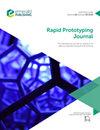使用激光箔印刷工艺制作无裂纹铝合金 6061 零件
IF 3.4
4区 工程技术
Q1 ENGINEERING, MECHANICAL
引用次数: 0
摘要
目的 本文旨在介绍使用一种前景看好的激光增材制造工艺--激光箔打印(LFP)工艺--制造 6061 铝合金(AA6061)的情况。尽管由于热裂纹问题,AA6061 对激光快速成型制造工艺而言具有挑战性,但本文仍建立了 AA6061 在 LFP 中的工艺窗口,以优化工艺参数,从而制造出高强度、致密且无裂纹的零件。使用维氏硬度和拉伸试验测试了 LFP 制造的 AA6061 部件的机械性能。研究结果利用 LFP 的最佳工艺参数成功制造出了无裂纹 AA6061 零件,其相对密度高达 99.8%。与传统的激光粉末床熔融(LPBF)工艺制作的 AA6061 样品相比,LFP 制成的零件具有优异的抗拉强度和相当的延展性。EBSD 结果表明,裂纹的形成与熔池的冷却速度有关,因为裂纹倾向于在较细的晶粒结构中形成,而这些晶粒结构是在较短的凝固时间和较高的冷却速度下形成的。 原创性/价值 本研究展示了使用 LFP 制造无裂纹 AA6061 零件的开创性成果,在激光熔化过程中无需预热基体或在熔池中混合纳米颗粒。该研究包括对机械性能和晶粒结构的全面检查,并与通过传统 LPBF 方法制造的零件进行了比较。本文章由计算机程序翻译,如有差异,请以英文原文为准。
Fabrication of crack-free aluminum alloy 6061 parts using laser foil printing process
Purpose
This paper aims to present the fabrication of 6061 aluminum alloy (AA6061) using a promising laser additive manufacturing process, called the laser-foil-printing (LFP) process. The process window of AA6061 in LFP was established to optimize process parameters for the fabrication of high strength, dense and crack-free parts even though AA6061 is challenging for laser additive manufacturing processes due to hot-cracking issues.
Design/methodology/approach
The multilayers AA6061 parts were fabricated by LFP to characterize for cracks and porosity. Mechanical properties of the LFP-fabricated AA6061 parts were tested using Vicker’s microhardness and tensile testes. The electron backscattered diffraction (EBSD) technique was used to reveal the grain structure and preferred orientation of AA6061 parts.
Findings
The crack-free AA6061 parts with a high relative density of 99.8% were successfully fabricated using the optimal process parameters in LFP. The LFP-fabricated parts exhibited exceptional tensile strength and comparable ductility compared to AA6061 samples fabricated by conventional laser powder bed fusion (LPBF) processes. The EBSD result shows the formation of cracks was correlated with the cooling rate of the melt pool as cracks tended to develop within finer grain structures, which were formed in a shorter solidification time and higher cooling rate.
Originality/value
This study presents the pioneering achievement of fabricating crack-free AA6061 parts using LFP without the necessity of preheating the substrate or mixing nanoparticles into the melt pool during the laser melting. The study includes a comprehensive examination of both the mechanical properties and grain structures, with comparisons made to parts produced through the traditional LPBF method.
求助全文
通过发布文献求助,成功后即可免费获取论文全文。
去求助
来源期刊

Rapid Prototyping Journal
工程技术-材料科学:综合
CiteScore
8.30
自引率
10.30%
发文量
137
审稿时长
4.6 months
期刊介绍:
Rapid Prototyping Journal concentrates on development in a manufacturing environment but covers applications in other areas, such as medicine and construction. All papers published in this field are scattered over a wide range of international publications, none of which actually specializes in this particular discipline, this journal is a vital resource for anyone involved in additive manufacturing. It draws together important refereed papers on all aspects of AM from distinguished sources all over the world, to give a truly international perspective on this dynamic and exciting area.
-Benchmarking – certification and qualification in AM-
Mass customisation in AM-
Design for AM-
Materials aspects-
Reviews of processes/applications-
CAD and other software aspects-
Enhancement of existing processes-
Integration with design process-
Management implications-
New AM processes-
Novel applications of AM parts-
AM for tooling-
Medical applications-
Reverse engineering in relation to AM-
Additive & Subtractive hybrid manufacturing-
Industrialisation
 求助内容:
求助内容: 应助结果提醒方式:
应助结果提醒方式:


